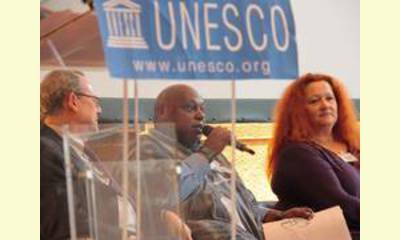|
|
UNESCO conference urges UN to include free expression in post-2015 development goals
un articulo por UNESCO media services
A two day conference marking World Press Freedom Day
at UNESCO Headquarters ended Tuesday [May 6] with a
Declaration that highlights the contribution of free
expression to development.

© UNESCO/P. Chiang-JooWorld Press Freedom Day International Conference at UNESCO headquarters, 5-6 May 2014.
click on photo to enlarge
The Declaration adopted today calls
for freedom of expression, press freedom,
independent media and access to information to be
fully integrated into the Sustainable Development
Goals (SDGs) that will replace the Millennium
Development Goals (MDGs) next year. It makes a
link between the free expression issues and good
governance, which is a foundation for development.
The Declaration specifically urges the United
Nation’s Open Working Group (OWG), the body that
is drafting the SDGs, to include free expression
as part of a good governance goal, as recommended
by the UN High Level Panel of Eminent Persons.
The conference document further encourages UNESCO
Member States to support these proposals at OWG
meetings. It calls for the OWG to recognize the
importance of universal access to information and
communication technologies and for governments to
make available “comprehensive, reliable, accurate
and accessible information related to the
development agenda” as part of the SDGs.
More than 300 participants from almost 90
countries took part in the deliberations,
including several Permanent Delegations to UNESCO.
A total of 75 speakers addressed the theme “Media
Freedom for a Better Future: Shaping the Post-2015
Development Agenda”.
During the event, participants discussed the
UNESCO report World Trends in Freedom of
Expression and Media Development. The French
edition and the regional chapters were also
launched. In addition, a consultation also took
place concerning UNESCO’s mandated study on Internet-related issues,
and on preparations to observe an International
Day to End Impunity for Crimes Against Journalists
on 2 November, in keeping with a recently-adopted
UN General Assembly resolution.
The Ambassador of Latvia to UNESCO, Ms Sanita
Pavluta-Deslandes, announced that Latvia will host
World Press Freedom Day in 2015.
|








|
DISCUSSION
Pregunta(s) relacionada(s) al artículo :
Free flow of information, How is it important for a culture of peace?
* * * * *
Comentario más reciente:
:
Perhaps the simplest way to illustrate the essential importance of free flow of information for a culture of peace is to discuss the importance of the control of information for the culture of war.
Here are excerpts from an Washington Post investigation two years ago entitled Top Secret America: A hidden world, growing beyond control. To read the original, click here.
"* Some 1,271 government organizations and 1,931 private companies work on programs related to counterterrorism, homeland security and intelligence in about 10,000 locations across the United States.
* An estimated 854,000 people, nearly 1.5 times as many people as live in Washington, D.C., hold top-secret security clearances.
* In Washington and the surrounding area, 33 building complexes for top-secret intelligence work are under construction or have been built since September 2001. Together they occupy the equivalent of almost three Pentagons or 22 U.S. Capitol buildings - about 17 million square feet of space.
* Many security and intelligence agencies do the same work, creating redundancy and waste. For example, 51 federal organizations and military commands, operating in 15 U.S. cities, track the flow of money to and from terrorist networks.
* Analysts who make sense of documents and conversations obtained by foreign and domestic spying share their judgment by publishing 50,000 intelligence reports each year - a volume so large that many are routinely ignored." . . .
"Every day across the United States, 854,000 civil servants, military personnel and private contractors with top-secret security clearances are scanned into offices protected by electromagnetic locks, retinal cameras and fortified walls that eavesdropping equipment cannot penetrate. . .
Much of the information about this mission is classified. That is the reason it is so difficult to gauge the success and identify the problems of Top Secret America, including whether money is being spent wisely. The U.S. intelligence budget is vast, publicly announced last year as $75 billion, 21/2 times the size it was on Sept. 10, 2001. But the figure doesn't include many military activities or domestic counterterrorism programs."
As we said in the draft Declaration and Programme of Action on a Culture of Peace that we sent from UNESCO to the UN General Assembly in 1998:
"98. It is vital to promote transparency in governance and economic decision-making and to look into the proliferation of secrecy justified in terms of 'national security', 'financial security', and 'economic competitiveness'. The question is to what extent this secrecy is compatible with the access to information necessary for democratic practice and social justice and whether, in some cases, instead of contributing to long-term security, it may conceal information about processes (ecological, financial, military, etc.) which are a potential threat to everyone and which need therefore to be addressed collectively."

|
|









